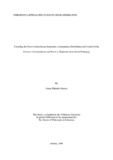Please use this identifier to cite or link to this item:
https://elibrary.tucl.edu.np/handle/123456789/1527| Title: | Indigenous approaches to knowledge generation |
| Authors: | Gurung, Ganga Bahadur |
| Keywords: | Pariyar community;Knowledge generation;School pedagogy;Education |
| Issue Date: | Jan-2009 |
| Publisher: | Faculty of Education, Tribhuvan University Kirtipur |
| Abstract: | The purpose of the study was to uncover the approaches to knowledge generation, continuation, distribution and control of the Pariyars, one of the least privileged caste groups of Nepal. I even tried to explore the commonalities and points of departure between the Pariyars' indigenous knowledge and our school pedagogy. The principal research question of my study was: How do the Pariyars of Nepal generate the knowledge regarding music and what are the indigenous approaches they use in knowledge generation? To ease my study, I formulated three subsidiary questions focusing on knowledge distribution, control and the ways to knowledge generation at home and at school. The review of the literature covered the general review of different types of literature regarding the Panchai Baja followed by the review of specific theoretical closures regarding the knowledge generation of the Pariyars and the issues linked herewith. As my study area was basically focused on the perceptions of the individuals regarding the culture they live in, their ways of knowledge generation and other ideas associated to indigenous knowledge, I adopted the qualitative research methods. Since my study was more cultural and was more linked with the perceptions of the individuals, I used ethnographic methods to unveil the indigenous knowledge of the Pariyars. I selected four families in which at least one member played the Panchai Baja. I chose the families purposively. However, later as I proceeded I took ten people as my research participants. For data gathering I used in-depth interviews, participant-observation and interviews with the people linked up with the Pariyars and the Panchai Baja. I recorded all the possible conversation with the help of video camera. After observing the data, I linked with corresponding theories to interpret them. I triangulated the data, triangulated the theoretical closures and gave meaning to my findings. The major finding was that children typically learnt their cultures by observation, imitation, and participation. The Pariyars distributed and controlled their knowledge within their communities alone. I even explored the dichotomy of auspiciousness and untouchability as a result of cultural hegemony. But my experience in the Pariyar community showed that conventional curricula and achievement tests, however, did not support students’ learning based on their indigenous knowledge. I found that the prescribed school pedagogy was alien and indifferent to the local knowledge of the Pariyars. The same school pedagogy was used in Kathmandu for the students of affluent family and it was the same school pedagogy that was used in the remote village of Gorkha district. Their local environment and other cultural aspects were largely ignored. Here I realized that learning environments need to be adapted to help students build on their indigenous communities’ knowledge and by recognizing students’ culture and value systems. I also felt that educators could further this type of education by combining appropriate pedagogical techniques. I also saw the concept of cultural capital playing an important role in helping people understand why social class influenced school success. I felt that social and cultural capital of the Pariyars are affected by each other and by the resources of economic, physical, technological or informational, and human capital. I had a great insight regarding the indigenous knowledge generation approaches and their importance in the field of education. |
| URI: | http://elibrary.tucl.edu.np/handle/123456789/1527 |
| Appears in Collections: | English Language Education |
Files in This Item:
| File | Description | Size | Format | |
|---|---|---|---|---|
| thesis.pdf | 2.21 MB | Adobe PDF |  View/Open |
Items in DSpace are protected by copyright, with all rights reserved, unless otherwise indicated.
